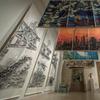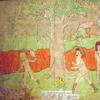The Time Is N♀w
- NEW YORK, New York
- /
- June 22, 2017
Michael Rosenfeld Gallery presents The Time Is Now, a group exhibition featuring thirty-two artists whose work the gallery has consistently championed for three decades through thematic group exhibitions as well as multiple solo shows.
The exhibition, which takes its title from a protest sign captured by Bettmann on Fifth Avenue in Manhattan during the Women’s Liberation Parade in August 1971, is curated to complement and expand on Making Space: Women Artists & Postwar Abstraction currently on view at the Museum of Modern Art (MoMA, New York). The Time Is Now features artists who represent a variety of positions on the spectrum from figural representation to abstraction, including: Magdalena Abakanowicz, Ruth Asawa, Hannelore Baron, Mary Bauermeister, Lee Bontecou, Deborah Butterfield, Barbara Chase-Riboud, Elaine de Kooning, Jay DeFeo, Claire Falkenstein, Gertrude Greene, Nancy Grossman, Grace Hartigan, Lee Krasner, Yayoi Kusama, Lee Lozano, Alice Trumbull Mason, Joan Mitchell, Alice Neel, Louise Nevelson, Agnes Pelton, Florence Miller Pierce, Irene Rice Pereira, Anne Ryan, Betye Saar, Kaye Sage, Janet Sobel, Nancy Spero, Dorothea Tanning, Lenore Tawney, Alma Thomas, Charmion von Wiegand, and Claire Zeisler.
Covering a period from 1937—Gertrude Greene’s collage (37X1)—to 1984—with works by Jay DeFeo (Untitled (Aoni/Ana)) and Nancy Spero (Untitled)—the exhibition reveals a rich diversity that implicitly challenges the singularity suggested by the notion of “women’s art.” Kay Sage’s hauntingly still The Fourteen Daggers (1942) shares an exhibition space with Lee Lozano’s dynamic Ram, a large-scale diptych from the artist’s Verb Paintings series. Both works are characterized by a photographic precision of line, which evokes surreal theatricality in the former and an almost hyper-real, cinematic close up in the latter. The Fourteen Daggers was included in the landmark 1942 First Papers of Surrealism exhibition, organized by André Breton and Marcel Duchamp; the largest surrealist exhibition ever held in the United States at the time, First Papers of Surrealism hailed the arrival of surrealist artists who had fled Europe for the United States at the outbreak of World War II, including Sage. Executed between 1964 and 1967, Lozano’s Verb Paintings feature hard-edged, abstracted extreme close ups of tools and machinery. While their emphasis on the ordinary may evoke her pop art contemporaries, Lozano’s Verb paintings emphasize the processes of creative and destructive work.
Additional highlights include the floating dynamism of Claire Falkenstein’s copper-and-enamel Sun (c. 1960) and The Albino (aka All That Rises Must Converge/Black), a monumental 1972 sculpture of black bronze, silk, wool, linen, and synthetic fibers by Barbara Chase-Riboud. In addition to being based on Chase-Riboud’s poem of the same name, The Albino emerged from the artist’s experimentation with the three-dimensionality of sculpture. Presented in its horizontal, open form, the sculpture is known as The Albino and is characterized by two impressive wings that spread out from a centralizing body that rests on the floor. In its closed, vertical incarnation, the sculpture forms a tall, totemic pillar and is known as All That Rises Must Converge/Black. Treated as two different sculptures by the art historian Peter Selz, The Albino (aka All That Rises Must Converge/Black) resists a singular reading and instead, opens itself up, quite literally, to multiple readings. Like Chase-Riboud’s work, Falkenstein’s “linear drawing in space”—as she called her wire constructions—incorporates exhibition space as a sculptural medium. As Maren Henderson has written, “In Sun, slender rods are configured in loops projecting in every direction but secured by skeins of copper wire. The result is a lattice network of baffling complexity. … the lattice structure is the medium, providing an envelope for space, light, and in this case the color red – provided by a red object tucked well into the interior.”
Since its inception in 1989, Michael Rosenfeld Gallery has been deeply committed to presenting the full story of American art, showcasing all who were active and contributing to the canon of American Art. For nearly three decades, the Gallery has sought to exhibit the work of celebrated artists alongside those whose works were eclipsed by the familiar historical narrative that focused almost exclusively on American art’s European (patri)lineage. The Gallery’s exhibitions have played a significant role in highlighting the achievements of artists historically marginalized in the mainstream art world due to both active and passive discrimination on the basis of race and gender.
Michael Rosenfeld Gallery is the exclusive representative of Hannelore Baron, Barbara Chase-Riboud, Claire Falkenstein, Nancy Grossman, and Charmion von Wiegand. Of the artists included in The Time Is Now, the Gallery has presented multiple solo exhibitions for Chase-Riboud, DeFeo, Falkenstein, Grossman, Rice Pereira, Ryan, Saar, Tawney, Thomas, and von Wiegand.
Michael Rosenfeld Gallery is located in Chelsea, at 100 Eleventh Avenue, New York, NY, 10011. Summer gallery hours are Monday–Friday, 10:00AM–6:00PM. For visuals and additional information, please contact Marjorie Van Cura at (212) 247-0082 or mv@michaelrosenfeldart.com.
Contact:
Marjorie Van CuraMichael Rosenfeld Gallery
212-247-0082
mv@michaelrosenfeldart.com
100 Eleventh Ave @ 19th Street
New York, New York
info@michaelrosenfeldart.com
212-247-0082
http://www.michaelrosenfeldart.com






100x100_c.jpg)


![Peter Paul Rubens (Flemish, 1577–1640), After Titian (Tiziano Vecelli) (Italian [Venetian], c. 1488–1576), Rape of Europa, 1628–29. Oil on canvas, 71 7/8 x 79 3/8 in. Peter Paul Rubens (Flemish, 1577–1640), After Titian (Tiziano Vecelli) (Italian [Venetian], c. 1488–1576), Rape of Europa, 1628–29. Oil on canvas, 71 7/8 x 79 3/8 in.](/images/c/e2/2e/Jan20_Rape_of_Europa100x100_c.jpg)






